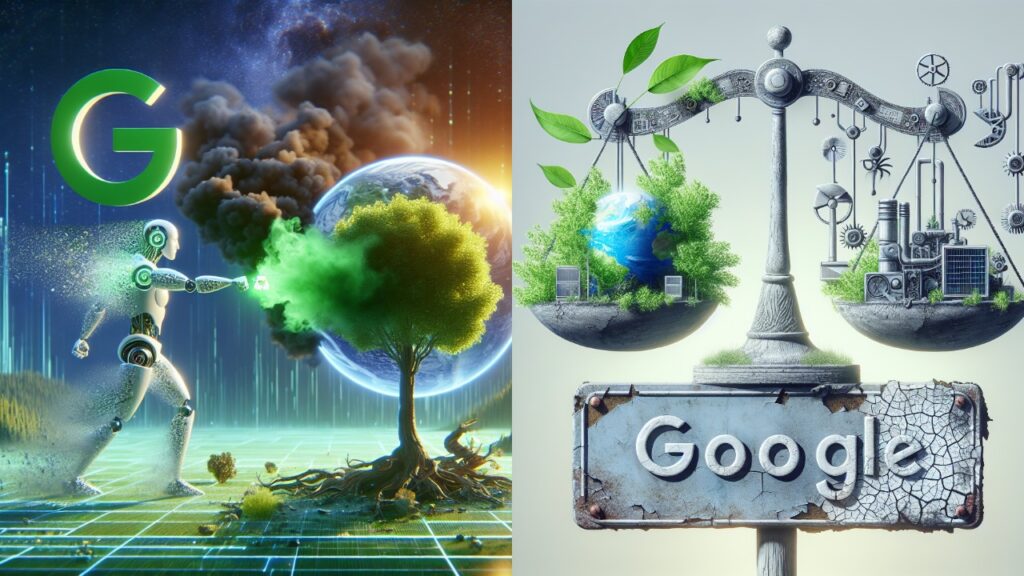The tech giant’s most recent environmental report states that, after 17 years, Google has abandoned its pledge to be carbon neutral because of the increase in emissions brought on by its pursuit of AI.
In order to offset the majority of the emissions it produces from its buildings and data centers, Google has stated that it has purchased enough clean energy since 2007. Yet as of 2023, the paper claims that Google has not “maintained operational carbon neutrality.”
This is due to a nearly 50% increase in Google’s greenhouse gas emissions since 2019, according to the corporation. The jump was attributed to rising energy requirements brought on by AI computation’s increased intensity as well as emissions from the larger infrastructural expenditure that AI necessitates.
The head of Google DeepMind, the company’s AI development lab, Demis Hassabis, has announced that Google will invest close to $100 billion in AI over the coming years. The company’s AI summaries in Search and Google’s Gemini, a large language model that can power a variety of AI tools and is intended to rival OpenAI’s ChatGPT, are the most obvious outcomes of that investment thus far.
But as Nathan Truitt, executive vice president of climate funding at the nonprofit American Forest Foundation, pointed out, there is a cost associated with that investment, and the environment pays the highest price.
AI will undoubtedly result in a sharp rise in emissions for the businesses that have made significant investments in it, according to Truitt. And it will result in an announcement similar to the one made by Google, wherein they will need to reevaluate their climate goals.
Net-zero versus carbon neutral
Despite the news, Google has not given up on cutting its emissions entirely. Instead, the corporation outlined another objective in the report: achieving net-zero emissions by 2030.
A goal of net-zero emissions and a goal of carbon neutrality differ significantly. Without necessarily lowering emissions at the source, being carbon neutral means offsetting or neutralizing emissions through carbon-removal activities like planting trees or buying carbon credits. Truitt compared it to someone attempting to lose extra calories by exercising alone and not altering their diet. That would be fine in principle, but Truitt said it’s highly unlikely to work in reality.
In contrast, net zero entails minimizing emissions at the source (the “diet”) and compensating for any leftover emissions by carbon removal operations (the “exercise” element).
This combination is “much much more effective, and also extremely ambitious,”. They will have to find quick solutions to a number of extremely difficult technological, logistical, budgetary, and economic problems at the same time, according to Truitt.
Google aims to have a more “certain” and “scalable” environmental impact by concentrating on both cutting greenhouse gas emissions and offsetting carbon emissions, according to the paper.
Aiming for net-zero emissions may also assist Google in avoiding criticism leveled at its claims of being carbon neutral by some experts. Critics have questioned whether planting a few thousand trees or paying tribes to conserve their forests are effective ways to “offset” carbon emissions.
Truitt wants organizations and advocacy groups to be understanding of companies that declare themselves carbon neutral, even in the face of criticism. He maintained that we shouldn’t punish businesses who make an effort to address environmental issues because doing so is riskier and more difficult than doing nothing at all.
Truitt believes that companies should be rewarded and allowed to make claims about using carbon offsets to address their emissions.
But he also said that he hoped businesses would become more leaders in climate policy and would no longer see it as a transactional issue.
According to Truitt, “I think we have to judge a company’s climate policies as a failure if they are doing everything right in terms of their specific carbon accounting policies, but they aren’t using that platform to figure out how to be part of the solution in terms of the systemic reform.”








